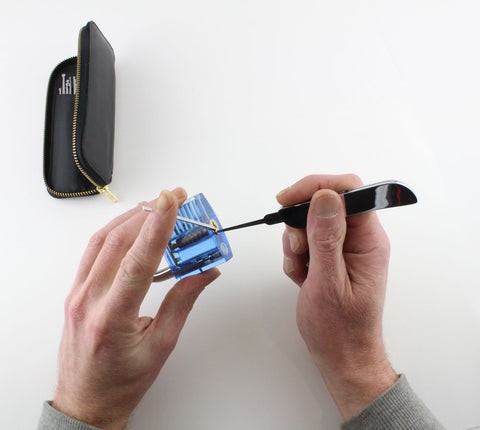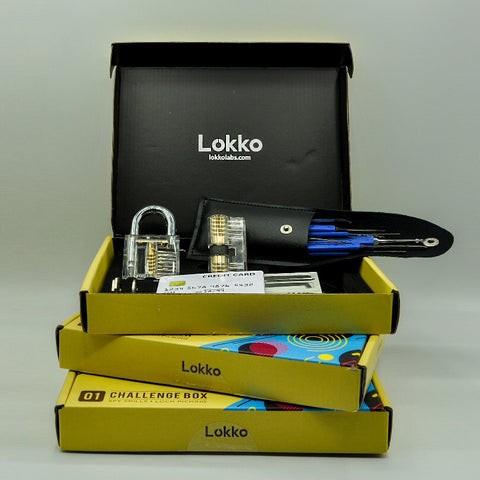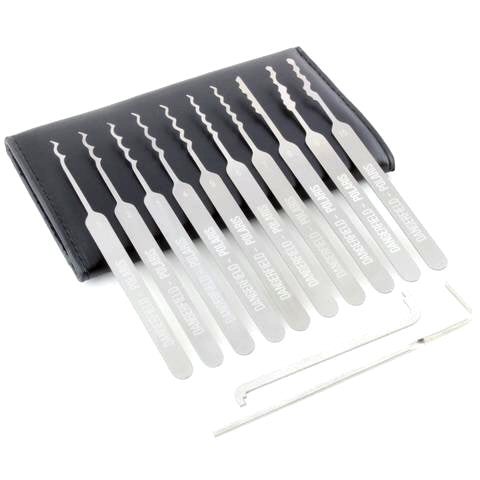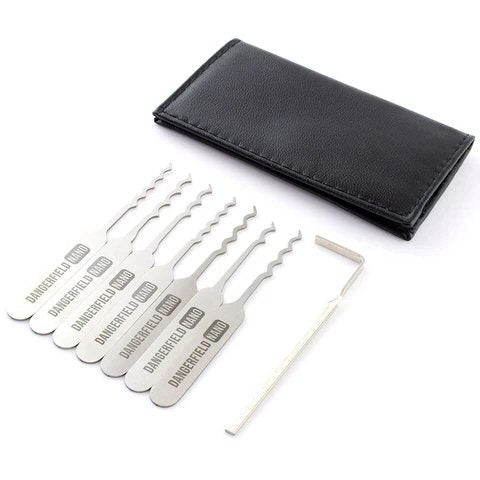Learning lockpicking can be an intriguing and rewarding skill. How Long Does It Take To Learn Lockpicking? It typically takes anywhere from a few hours to several months to become proficient, depending on your dedication, practice, and the complexity of the locks you aim to open. At LEARNS.EDU.VN, we provide resources and guidance to help you master this skill efficiently. Delve into the art of lock manipulation, refine your unlocking techniques, and grasp essential bypassing methods with our expert insights, designed to cater to all skill levels.
1. Understanding the Lockpicking Learning Curve
The journey to mastering lockpicking isn’t a sprint; it’s a marathon. The time it takes to learn lockpicking can vary significantly based on several factors. Understanding these elements can help you set realistic expectations and tailor your learning approach.
1.1. Factors Influencing Learning Time
- Natural Aptitude: Some individuals possess an innate ability to understand mechanical systems, which can accelerate the learning process.
- Practice Frequency: Consistent, regular practice is crucial. Short, daily sessions are more effective than infrequent, long ones.
- Learning Resources: Access to quality guides, tutorials, and experienced mentors can significantly impact your progress.
- Lock Complexity: Starting with simple locks and gradually increasing the difficulty is essential for building a solid foundation.
- Tools and Equipment: Using high-quality lock picks and practice locks can enhance your learning experience.
- Dedication and Patience: Lockpicking requires patience and persistence. Frustration can hinder progress, so a positive attitude is key.
1.2. Typical Timeframes
| Skill Level | Description | Timeframe |
|---|---|---|
| Beginner | Able to open basic pin tumbler locks with standard techniques. Understands the fundamentals of lock mechanics and the tools involved. | A few hours to a week |
| Intermediate | Proficient in opening a wider variety of locks, including those with security pins. Can use multiple picking techniques and diagnose common issues. | 1-3 months |
| Advanced | Capable of opening high-security locks and mastering advanced techniques like impressioning and bypass methods. Possesses a deep understanding of lock design and can adapt to new challenges. | 6+ months |
| Expert | Mastery of all aspects of lockpicking. Can create custom tools, analyze and defeat complex security systems, and teach others effectively. | Years |







2. Essential Tools for Lockpicking Beginners
Having the right tools is crucial for a successful start in lockpicking. Investing in a quality set can make the learning process smoother and more enjoyable.
2.1. Basic Lock Pick Set
A beginner’s set should include a variety of picks to handle different types of locks. Essential picks include:
- Hook Picks: Versatile for single-pin picking (SPP).
- Diamond Picks: Useful for raking and general manipulation.
- Rake Picks: Designed to quickly open locks by simulating the action of a key.
- Tension Wrenches: Apply torque to the lock cylinder, creating the necessary tension for picking.
A beginner can realistically be picking locks on their first day. With the right tools and information, this is easily within reach.
2.2. Practice Locks
Starting with practice locks is highly recommended. These locks are designed to be easier to pick, allowing you to develop your skills without the frustration of dealing with complex security features.
- Clear Practice Locks: Transparent locks that allow you to see the internal mechanisms in action.
- Cut-Away Locks: Locks with sections removed to expose the pins and cylinders.
- Progressive Pinning Locks: Locks with adjustable pin configurations, allowing you to gradually increase the difficulty.
2.3. Additional Useful Tools
- Magnifying Glass: Helps to see the small details inside the lock.
- Lubricant: Keeps the lock mechanisms smooth and prevents wear.
- Work Mat: Provides a stable and clean surface for practicing.
3. Fundamental Lockpicking Techniques
Mastering basic lockpicking techniques is essential for building a solid foundation. Here are some key methods to learn:
3.1. Single Pin Picking (SPP)
Single Pin Picking is a fundamental technique where you manipulate each pin individually to open the lock.
3.1.1. The SPP Process
- Apply Tension: Insert the tension wrench into the keyway and apply a slight turning force.
- Insert Pick: Insert the pick into the keyway, carefully feeling for each pin.
- Set Pins: Use the pick to lift each pin until it clicks into place, indicating it has reached the shear line.
- Turn Cylinder: Once all pins are set, the cylinder should turn, opening the lock.
A good guide is also essential when learning the basics of how a lock works. Make sure you get a guide with decent and many illustrations. Combine that with a clear or cut-away lock and you’ll soon be picking locks.
3.1.2. Tips for SPP Success
- Listen to Feedback: Pay attention to the sounds and vibrations transmitted through the pick and tension wrench.
- Practice Regularly: Consistent practice is key to developing the necessary tactile skills.
- Use Clear Locks: Start with clear locks to visualize the process, then move to opaque locks to develop your feel.
3.2. Raking
Raking is a faster technique that involves using a specialized pick to manipulate all the pins simultaneously.
3.2.1. The Raking Process
- Apply Tension: Insert the tension wrench and apply a slight turning force.
- Insert Rake: Insert the rake pick into the keyway.
- Rake Pins: Move the rake back and forth, up and down, or in elliptical patterns to jostle the pins into the correct position.
- Turn Cylinder: Once the pins are set, the cylinder should turn, opening the lock.
3.2.2. Tips for Raking Success
- Experiment with Rakes: Try different rake designs to find what works best for various locks.
- Adjust Tension: Vary the tension to find the optimal pressure for setting the pins.
- Combine with SPP: Use raking to quickly set some pins, then switch to SPP to set the remaining ones.
3.3. Tensioning Techniques
Proper tensioning is crucial for both SPP and raking. There are two main methods:
- Top of Keyway (TOK): Applying tension at the top of the keyway, which can provide more space for maneuvering the pick.
- Bottom of Keyway (BOK): Applying tension at the bottom of the keyway, which is often easier for beginners.
Experiment with both methods to find what feels most comfortable and effective for different locks.
4. Advanced Lockpicking Techniques
Once you’ve mastered the basics, you can move on to more advanced techniques to tackle tougher locks.
4.1. Impressioning
Impressioning is the art of creating a working key from a blank key by analyzing the marks left on the key as it is inserted and manipulated in the lock.
4.1.1. The Impressioning Process
- Prepare Blank Key: Insert a blank key into the lock and apply slight turning pressure.
- File Marks: Remove the key and file down the areas where marks appear.
- Repeat: Repeat the process until the key opens the lock.
4.1.2. Tips for Impressioning Success
- Use Soft Blanks: Use key blanks made of soft metal to make marking easier.
- File Gradually: File small amounts at a time to avoid overcutting.
- Be Patient: Impressioning can be a time-consuming process that requires patience and precision.
4.2. Bypass Tools
Bypass tools allow you to open locks without manipulating the pins. These tools exploit vulnerabilities in the lock’s design.
4.2.1. Common Bypass Tools
- Mica Sheets: Thin sheets of plastic used to slip between the door and frame to depress the latch.
- Thumbturn Picks: Tools designed to manipulate thumbturn locks from the outside.
- Decoder Tools: Tools used to decode and open certain types of locks.
4.2.2. Ethical Considerations
It’s important to use bypass tools responsibly and ethically. Only use them on locks you own or have permission to open.
4.3. Dealing with Security Pins
Security pins are designed to make lockpicking more difficult. Common types include:
- Spool Pins: Pins with a narrow section that can create a false set.
- Serrated Pins: Pins with serrations that provide tactile feedback similar to a set pin.
- Mushroom Pins: Pins with a mushroom-shaped head that can also create a false set.
Learning to recognize and overcome these pins is crucial for advancing your lockpicking skills.
5. Practice Strategies and Resources
Effective practice is key to mastering lockpicking. Here are some strategies and resources to help you improve.
5.1. Structured Practice Routine
- Warm-Up: Start with simple locks to get your fingers and mind ready.
- Focus on Technique: Concentrate on specific techniques, such as SPP or raking.
- Increase Difficulty: Gradually move to more complex locks with security pins.
- Review Progress: Regularly assess your progress and identify areas for improvement.
5.2. Online Resources
- LEARNS.EDU.VN: Offers comprehensive guides, tutorials, and resources for lockpicking enthusiasts.
Address: 123 Education Way, Learnville, CA 90210, United States.
Whatsapp: +1 555-555-1212.
Website: LEARNS.EDU.VN - YouTube: Provides a wealth of video tutorials on various lockpicking techniques.
- Lockpicking Forums: Online communities where you can ask questions, share tips, and connect with other enthusiasts.
5.3. Books and Guides
- “Visual Guide to Lock Picking”: A comprehensive guide with detailed illustrations.
- “Lock Picking: A Detailed How-to Pick Locks Book”: A glossy, easy-to-read guide for beginners.
6. Ethical and Legal Considerations
Lockpicking can be a fascinating hobby, but it’s important to practice it ethically and legally.
6.1. Legal Restrictions
Lockpicking laws vary by region. In many places, it is illegal to possess lockpicking tools with the intent to use them for illegal purposes. Always be aware of the laws in your area.
6.2. Ethical Guidelines
- Only Pick Locks You Own: Never pick locks that you do not have permission to open.
- Respect Property Rights: Lockpicking should not be used to violate property rights or commit crimes.
- Practice Responsibly: Use your skills for legitimate purposes, such as security testing or recreational activities.
6.3. Responsible Lockpicking
Responsible lockpicking involves respecting the law, adhering to ethical guidelines, and using your skills for good. By practicing responsibly, you can enjoy the hobby without causing harm or violating trust.
7. Overcoming Common Challenges
Lockpicking can be challenging, and it’s common to encounter obstacles along the way. Here are some tips for overcoming common challenges:
7.1. Difficulty Feeling Pins
- Practice with Clear Locks: Use clear locks to visualize the pin movements.
- Adjust Tension: Experiment with different tension levels to improve feedback.
- Use Quality Picks: Invest in high-quality picks that provide better tactile feedback.
7.2. False Sets
- Recognize Security Pins: Learn to identify the characteristics of security pins, such as spool and serrated pins.
- Use Counter-Rotation: Apply slight counter-rotation to overcome false sets.
- Be Patient: False sets can be frustrating, but with practice, you’ll learn to recognize and overcome them.
7.3. Breaking Picks
- Use Proper Technique: Avoid applying excessive force when picking.
- Inspect Picks Regularly: Check your picks for signs of wear and tear.
- Invest in Quality Picks: High-quality picks are less likely to break under normal use.
8. The Future of Lockpicking
Lockpicking is an evolving field, with new technologies and techniques constantly emerging. Staying up-to-date with the latest developments can help you stay ahead of the curve.
8.1. Technological Advancements
- Smart Locks: Electronic locks that use keypads, biometric scanners, or smartphone apps for access.
- 3D-Printed Locks: Custom-designed locks that can be difficult to pick.
- AI-Powered Lockpicking Tools: Tools that use artificial intelligence to automate the lockpicking process.
8.2. Staying Current
- Attend Lockpicking Conferences: Network with experts and learn about the latest techniques.
- Read Industry Publications: Stay informed about new technologies and trends.
- Engage with Online Communities: Participate in discussions and share your knowledge.
9. Lockpicking as a Hobby and a Skill
Lockpicking can be both a rewarding hobby and a valuable skill. Whether you’re interested in the challenge of opening complex locks or the practical applications of security testing, there’s something for everyone to enjoy.
9.1. Benefits of Learning Lockpicking
- Problem-Solving Skills: Lockpicking requires analytical thinking and creative problem-solving.
- Fine Motor Skills: Manipulating small tools and feeling subtle feedback improves dexterity.
- Knowledge of Security Systems: Understanding how locks work can help you appreciate and improve security measures.
- Hobby and Recreation: Lockpicking can be a fun and engaging hobby that provides a unique challenge.
9.2. Career Opportunities
- Locksmith: Locksmiths install, repair, and maintain locks and security systems.
- Security Consultant: Security consultants assess vulnerabilities and recommend security improvements.
- Forensic Locksmith: Forensic locksmiths analyze locks and security systems for law enforcement investigations.
10. Finding the Right Learning Path at LEARNS.EDU.VN
At LEARNS.EDU.VN, we understand that every learner is unique. That’s why we offer a variety of resources and learning paths to suit your individual needs and goals.
10.1. Personalized Learning Plans
- Assessment Tools: Identify your current skill level and learning objectives.
- Customized Curriculum: Receive a personalized learning plan tailored to your needs.
- Progress Tracking: Monitor your progress and adjust your plan as needed.
10.2. Expert Guidance
- Experienced Instructors: Learn from experienced lockpicking professionals.
- One-on-One Coaching: Receive personalized feedback and guidance.
- Community Support: Connect with other learners and share your experiences.
10.3. Comprehensive Resources
- Detailed Guides: Access in-depth guides covering all aspects of lockpicking.
- Video Tutorials: Watch step-by-step video tutorials demonstrating various techniques.
- Practice Materials: Download practice templates and access interactive simulations.
By choosing LEARNS.EDU.VN, you’re investing in a comprehensive and effective lockpicking education. Whether you’re a complete beginner or an experienced enthusiast, we have the resources and expertise to help you achieve your goals.
FAQ: Frequently Asked Questions About Lockpicking
1. Is lockpicking legal?
Lockpicking legality varies by location. Generally, owning lockpicking tools is legal unless you intend to use them for illegal activities. Always check local laws.
2. What is single-pin picking (SPP)?
SPP involves manipulating each pin individually using a pick and tension wrench to open a lock.
3. How do I choose the right lock pick set?
Start with a beginner set that includes hooks, diamonds, rakes, and tension wrenches. Quality and variety are key.
4. What are practice locks and why should I use them?
Practice locks are designed to be easier to pick, allowing you to develop skills without frustration. Clear locks let you see the internal mechanisms.
5. How long does it take to become proficient at lockpicking?
Proficiency varies. Beginners can open basic locks in a few hours to a week, while advanced skills take months of practice.
6. What is raking and how does it differ from SPP?
Raking involves using a specialized pick to manipulate all pins simultaneously, making it faster than SPP.
7. What are security pins and how do I handle them?
Security pins like spool and serrated pins make lockpicking harder. Learn to recognize and counter their effects with proper techniques.
8. Where can I find reliable lockpicking resources and tutorials?
LEARNS.EDU.VN offers comprehensive guides, tutorials, and expert guidance. YouTube and online forums also provide valuable resources.
9. How can I practice lockpicking ethically and responsibly?
Only pick locks you own or have permission to open. Respect property rights and use your skills for legitimate purposes.
10. What are some common challenges in lockpicking and how can I overcome them?
Challenges include difficulty feeling pins, dealing with false sets, and breaking picks. Practice with clear locks, adjust tension, and use quality tools.
Ready to unlock your potential and master the art of lockpicking? Visit LEARNS.EDU.VN today to explore our comprehensive resources, personalized learning plans, and expert guidance. Whether you’re a beginner or an experienced enthusiast, we have everything you need to succeed. Start your lockpicking journey with us and discover a world of skill, knowledge, and opportunity. Contact us at:
Address: 123 Education Way, Learnville, CA 90210, United States.
Whatsapp: +1 555-555-1212.
Website: learns.edu.vn
Our LOKKO beginners box with lock picks, clear locks, and a guide. You can also select from the drop-down menu to get it with a digital guide, a color paperback guide, and even with more practice locks.
Cut-away locks allow you to see how the pins respond to your picks, and how they respond to the correct key being inserted.
21-pc Praxis Dual-Gauge Lock Pick Set. Great picks, rakes, and both top of keyway and bottom of keyway tension tools. An all-round pro set of lock picks.
Polaris Rake Set—probably the best set of rakes to pick locks with in the world. I spent over a year developing this set of rakes as I wanted a fully comprehensive set of rakes that came with 5,000-word digital guide to advanced raking techniques so people understood there was a lot more to raking than just moving your rake in and out.
Covert Nano Rake Set with wrench in magnetic real leather case. Exceptional raking potential that can either be slipped into your favorite lock pick set to improve it, or slipped into your jacket for emergencies.
Multipick Kronos Electric Pick Gun—one of the finest and easiest-to-use lock-picking tools ever.
The KLOM Budget Lock Pick Gun. A fantastic electric lock pick gun that won’t break the bank. Ideal for the beginner who wants to try this most effective of techniques.
Peterson 4-piece Thumbturn tool set. Left & right and in two gauges. These tools exploit the fact that locks with a thumbturn on the inside aren’t actually locked. Insert the tool through the lock and past the pins and turn the cam yourself, which opens the lock
